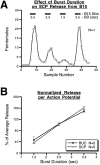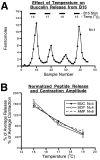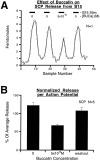Release of peptide cotransmitters in Aplysia: regulation and functional implications
- PMID: 8987835
- PMCID: PMC6579220
- DOI: 10.1523/JNEUROSCI.16-24-08105.1996
Release of peptide cotransmitters in Aplysia: regulation and functional implications
Abstract
To gain insights into the physiological role of cotransmission, we measured peptide release from cell B15, a motorneuron that utilizes ACh as its primary transmitter but also contains putative peptide cotransmitters, the small cardioactive peptides (SCPs) and the buccalins (BUCs). All stimulation parameters used were in the range in which B15 fires in freely moving animals. We stimulated neuron B15 in bursts and systematically varied the interburst interval, the intraburst frequency, and burst duration. Both peptides were preferentially released when B15 was stimulated at higher intra- or interburst frequencies or with longer burst durations. Across stimulation patterns, the amount of peptide released depended on the mean frequency of stimulation and was independent of the specific pattern of stimulation. The parameters of stimulation that produce a larger release of peptides correspond to those that evoke larger contractions. Large and frequent contractions are likely to fuse or summate, thus disrupting the rhythmic behavior mediated by the muscle innervated by motorneuron B15. Because the combined effect of the SCPs and BUCs is to accelerate the relaxation and shorten the duration of muscle contractions, these peptides reduce the probability of the disruptive fusion or summation of muscle contractions. Because these cotransmitters regulate an aspect of muscle contractions that is not controlled by acetylcholine (ACh), the primary transmitter of B15, we suggest that peptides and ACh form parallel but functionally distinct lines of transmission at the neuromuscular junction. Both types of transmission may be necessary to ensure that behavior remains efficient over a wide range of conditions.
Figures










Similar articles
-
Neuropeptide cotransmitters released from an identified cholinergic motor neuron modulate neuromuscular efficacy in Aplysia.J Neurosci. 1990 Oct;10(10):3313-22. doi: 10.1523/JNEUROSCI.10-10-03313.1990. J Neurosci. 1990. PMID: 1976768 Free PMC article.
-
Frequency-dependent release of peptide cotransmitters from identified cholinergic motor neurons in Aplysia.Proc Natl Acad Sci U S A. 1989 Nov;86(22):9034-8. doi: 10.1073/pnas.86.22.9034. Proc Natl Acad Sci U S A. 1989. PMID: 2554338 Free PMC article.
-
Costorage and corelease of modulatory peptide cotransmitters with partially antagonistic actions on the accessory radula closer muscle of Aplysia californica.J Neurosci. 1996 Dec 15;16(24):8092-104. doi: 10.1523/JNEUROSCI.16-24-08092.1996. J Neurosci. 1996. PMID: 8987834 Free PMC article.
-
Functional roles of peptide cotransmitters at neuromuscular synapses in Aplysia.Mol Neurobiol. 1993 Fall-Winter;7(3-4):335-47. doi: 10.1007/BF02769181. Mol Neurobiol. 1993. PMID: 8179842 Review.
-
Peptidergic co-transmission in Aplysia: functional implications for rhythmic behaviors.Experientia. 1992 May 15;48(5):456-63. doi: 10.1007/BF01928164. Experientia. 1992. PMID: 1601110 Review.
Cited by
-
Release of a single neurotransmitter from an identified interneuron coherently affects motor output on multiple time scales.J Neurophysiol. 2013 May;109(9):2327-34. doi: 10.1152/jn.01079.2012. Epub 2013 Feb 13. J Neurophysiol. 2013. PMID: 23407357 Free PMC article.
-
Temperature compensation of neuromuscular modulation in aplysia.J Neurophysiol. 2005 Nov;94(5):3259-77. doi: 10.1152/jn.00481.2005. Epub 2005 Jun 8. J Neurophysiol. 2005. PMID: 15944231 Free PMC article.
-
Non-associative learning and serotonin induce similar bi-directional changes in excitability of a neuron critical for learning in the medicinal leech.J Neurosci. 2001 Feb 15;21(4):1401-12. doi: 10.1523/JNEUROSCI.21-04-01401.2001. J Neurosci. 2001. PMID: 11160412 Free PMC article.
-
Different microcircuit responses to comparable input from one versus both copies of an identified projection neuron.J Exp Biol. 2020 Oct 26;223(Pt 20):jeb228114. doi: 10.1242/jeb.228114. J Exp Biol. 2020. PMID: 32820029 Free PMC article.
-
The Aplysia mytilus inhibitory peptide-related peptides: identification, cloning, processing, distribution, and action.J Neurosci. 1999 Nov 1;19(21):9618-34. doi: 10.1523/JNEUROSCI.19-21-09618.1999. J Neurosci. 1999. PMID: 10531464 Free PMC article.
References
Publication types
MeSH terms
Substances
Grants and funding
LinkOut - more resources
Full Text Sources
